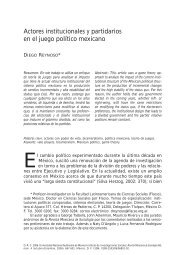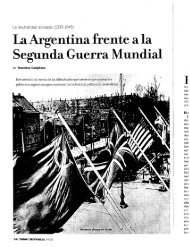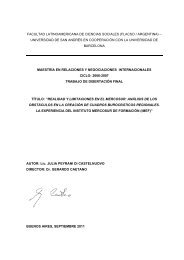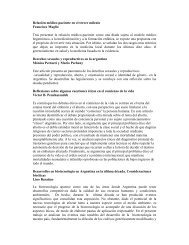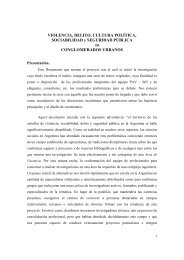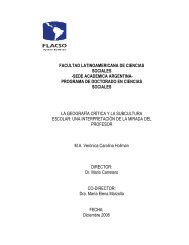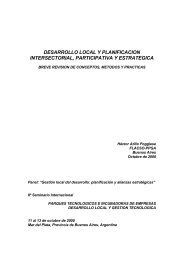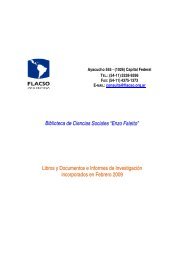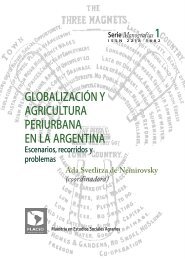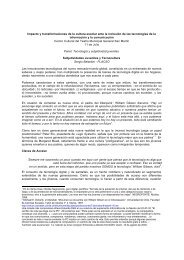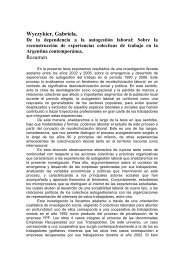Mercedes Botto Andrea Carla Bianculli - Flacso
Mercedes Botto Andrea Carla Bianculli - Flacso
Mercedes Botto Andrea Carla Bianculli - Flacso
Create successful ePaper yourself
Turn your PDF publications into a flip-book with our unique Google optimized e-Paper software.
no comparative statistical analyses. Apart from this basic survey, another important task had to do<br />
with the evaluation of the different possible scenarios and their expected impact on each of the<br />
national productive sectors.<br />
At the regional level, similar surveys were carried out. In 1993, the GMC appointed an expert, who<br />
was part of a research centre associated to the Brazilian government, the Instituto de Pesquisa<br />
Econômica Aplicada (IPEA). Financed with the technical aid provided by the EU and the Inter-<br />
American Development Bank (IADB), Honorio Kume was designated to perform this survey, and<br />
to assist national governments in the meetings of the GMC, where he turned out to be an active<br />
participant.<br />
In Argentina, the need to come up with a proposal for the CET gave way to a superposition of<br />
studies and the appointment of different working groups. In all, three special studies can be<br />
identified.<br />
A first group was composed of technical experts from the Ministry of Economy, who were to fulfil<br />
certain tasks regarding Mercosur, and academics from the Faculty of Economy at the Universidad<br />
de Buenos Aires (UBA) 29. This group was coordinated and financed through the Ministry’s budget<br />
and its main objective was to collect all the existing information about the tariff positions in the<br />
four member countries in order to build a comparative matrix. This survey was guided by the<br />
demands and particular requirements of the officials of this public agency, who were also part of<br />
the different working groups within Mercosur. In addition, these technical experts elaborated<br />
proposals and reports that were raised to the negotiators30. A second survey was appointed by the Ministry of Economy: financed through loans from the<br />
United Nations Development Program (UNDP), the survey was commissioned to a group of<br />
academics selected on a personal basis. The fees of these appointed experts tripled those of the<br />
Ministry officials who were responsible for the negotiation process, a situation that was thus<br />
regarded with suspicion. Even if the aims of this consultancy group were to provide advice and<br />
contribute to the design of the CET, the directives and parameters of the research were settled by<br />
the Undersecretary, and did not necessarily respond to the requirements of the actual negotiators.<br />
Instead, this group relied heavily on the information that they already had and on a matrix showing<br />
input data that was outdated.<br />
29 The tasks were divided between the UBA academics and the technical experts: while the latter focused on<br />
the development of the parameters – since there was a perceived need for this information during the<br />
negotiations – and the coordination of the different activities within this joint group, the former worked on<br />
the comparative study and elaborated diverse statistical measures given that this data was of great utility<br />
during the negotiations [Interview with public official].<br />
30 As one public official stated: “However, one asks for instructions, but we also make proposals and suggest, for instance,<br />
that all goods produced in the region should be protected, while those produced in third countries could be applied a tariff between<br />
0 and 2%. Nevertheless, the final decision – the exact level of the tariffs to be applied – lay in the hands of the Ministers.<br />
Therefore, they would just agree and decide that the maximum tariff level would be of 20% and that, then, this should be<br />
escalated by 2 in 2. These were the guidelines they gave for the elaboration of the CET proposals”.<br />
26




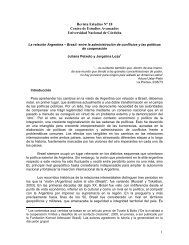
![[P] Disertacion.Melisa.Galvano.pdf - Flacso](https://img.yumpu.com/14596629/1/184x260/p-disertacionmelisagalvanopdf-flacso.jpg?quality=85)
